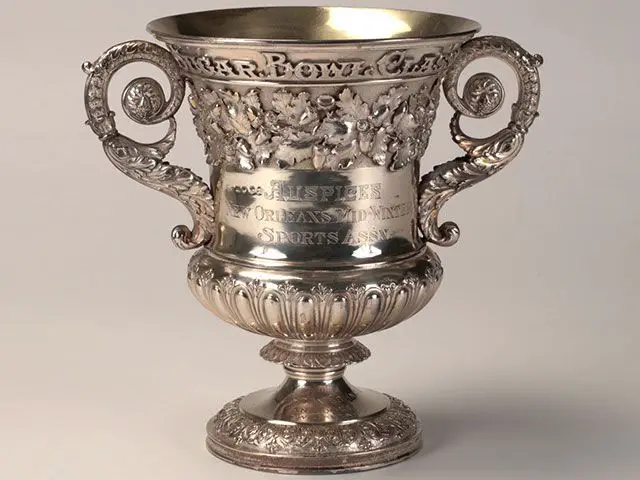What Is In The Sugar Bowl?
History of the Sugar Bowl
The Sugar Bowl is one of college football’s most historic bowl games, dating back to 1935. It originated when the New Orleans Mid-Winter Sports Association was looking to draw visitors and publicity to the city during the Great Depression. The inaugural Sugar Bowl game was played on January 1, 1935 at Tulane Stadium in New Orleans. It featured Tulane against Temple, with Tulane winning 20-14.
In the early years, the Sugar Bowl regularly featured teams from the Southeastern Conference (SEC) against national powerhouses. Some key moments include undefeated Tennessee beating Oklahoma in 1939, Georgia Tech stunning Missouri in 1945, and Alabama’s win over Syracuse in 1953 cementing Paul “Bear” Bryant’s first national title with the Crimson Tide.
The game continued to grow in prominence through the 50s-70s. Memorably, Archie Manning led #13 Ole Miss to an upset over #3 Arkansas in 1970. In 1975, #2 Alabama completed a perfect season by defeating #1 Penn State 13-6 in the first ever matchup of 1 vs 2 ranked teams in a bowl game.
Over 8 decades, the Sugar Bowl has featured some of the greatest teams, coaches, and players in college football history. It remains one of the premier bowl games today as part of the College Football Playoff, hosting a semifinal game every 3 years.
Sugar Bowl Location
The Sugar Bowl is held annually at the Mercedes-Benz Superdome in New Orleans, Louisiana. The Superdome opened in 1975 and has a seating capacity of over 76,000 for football games (Wikipedia). It is the home stadium of the NFL’s New Orleans Saints.
The Superdome has hosted the Sugar Bowl every year since 1975. Prior to that, the Sugar Bowl was held at Tulane Stadium from 1934 to 1974 (Sugar Bowl). The Sugar Bowl and Superdome have become synonymous with New Orleans and the game itself.
New Orleans was chosen as the annual host city for the Sugar Bowl due to its warm climate and reputation as a tourist destination. The Sugar Bowl continues to drive significant tourism revenue to New Orleans each year. Having a consistent location has allowed the Sugar Bowl to become deeply ingrained in the culture and identity of New Orleans.
Sugar Bowl Matchup
The Sugar Bowl pits a team from the SEC against a team from the Big 12 conference. The SEC has a long-standing tie-in with the Sugar Bowl dating back to 1976.1 The winner of the SEC Championship Game automatically qualifies for a spot in the Sugar Bowl, as long as that team is not selected for the College Football Playoff.2
For the Big 12, the conference champion gets an automatic bid if they are not selected for the playoff. If the Big 12 champion makes the playoff, then the next highest ranked Big 12 team goes to the Sugar Bowl.3 This ensures a quality matchup between top teams from two of the premier conferences in college football.
Notable Sugar Bowl Games
The Sugar Bowl has hosted many memorable and historic games over the years. Here are some highlights:
In the 1950 Sugar Bowl, #2 Oklahoma defeated #3 LSU 35-0 in what was considered one of the biggest mismatches in Sugar Bowl history. Oklahoma dominated the game from start to finish behind the stellar play of running back Billy Vessels, who ran for 195 yards and was named the game’s Most Outstanding Player [1].
The 1965 Sugar Bowl featured an epic showdown between #7 LSU and unranked Syracuse. This game is still considered one of the biggest upsets in college football bowl history, as LSU entered as heavy favorites but Syracuse stunned them 13-10 thanks to the heroic performance of running back Floyd Little [2].
In 1969, #13 Arkansas pulled off an unlikely 14-13 upset victory over #2 Georgia in the Sugar Bowl. The Razorbacks won on a 2-point conversion late in the fourth quarter, denying Georgia a potential national championship [3].
The 1977 Sugar Bowl saw #5 Alabama defeat #9 Ohio State 35-6 in a one-sided affair. Alabama running back Johnny Davis put on a show, rushing for 135 yards and 2 touchdowns on his way to earning Most Outstanding Player honors.
Overall, the Sugar Bowl has played host to countless thrilling finishes, stunning upsets, standout individual performances, and games that had national championship implications over the decades.
Sugar Bowl Traditions
The Sugar Bowl game has many long-standing traditions associated with it. One of the most notable is the Sugar Bowl Parade, held every year on the morning of the game [1]. Started in 1980, the parade features elaborate floats, marching bands, dance teams, and more. It winds through the streets of New Orleans with over 150 units participating. The parade serves as an exciting kickoff to the big game later that day.
Another tradition is the Mayor’s Luncheon, typically held the day before the game. This event brings together city leaders, coaches, university officials, media, and other special guests. It provides an opportunity to celebrate the upcoming matchup and highlight the game’s impact on New Orleans [2].
Fans of the two teams playing also host exciting pep rallies in the days leading up to the game. Marching bands, cheerleaders, mascots, and more rally the crowd’s spirit. For many fans, attending the pep rallies is a cherished ritual.
On game day, fans arrive early to tailgate in the parking lots around the stadium. This allows alumni and supporters of the two teams to socialize and build excitement before entering the stadium. The tailgates showcase each school’s spirit and traditions.
Sugar Bowl Trophies & Awards
The winning team of the Sugar Bowl is awarded the iconic Sugar Bowl trophy. This trophy is a sterling silver cup that was crafted in London in 1830 during the reign of King George IV. It features hallmarks indicating the silver purity and year it was assayed. The original trophy stands 22 inches tall and weighs over 130 ounces. It is engraved with flower and scroll motifs and has a removable liner. This historic trophy has been awarded to the Sugar Bowl winner since the first Sugar Bowl game in 1935.

In addition to the trophy, the winning team is also awarded a new trophy each year. Recent trophies have been crafted by jewelers such as Tiffany & Co. and feature creative designs incorporating sugar cane, fleur de lis symbols, and other Louisiana-inspired elements. The winning coach is given their own trophy as well.
The MVP of the Sugar Bowl is awarded the “Most Outstanding Player” trophy. This trophy depicts a football player kicking a football and sits atop a wooden base. The recipient’s name and year are engraved on the base. Both the winning team and the MVP take home prestigious prizes steeped in Sugar Bowl history and tradition. (Source)
Sugar Bowl Entertainment
The Allstate Sugar Bowl is known for having exciting entertainment and notable halftime shows. The halftime performance is one of the highlights of the Sugar Bowl game day experience.
For the 2024 Sugar Bowl, the halftime show will feature the marching bands from the participating universities, Texas and Washington, according to College Football Network. Marching bands from the competing schools often alternate performing at halftime in years when big name acts are not booked.
In recent years, the Sugar Bowl has featured high profile music acts during halftime. In 2023, country music star Luke Bryan performed a halftime concert. Other recent performers include Maroon 5 (2022), Post Malone (2021), and Jonas Brothers (2020). The selection of popular musical guests aims to enhance the entertainment value and draw more viewers.
The Sugar Bowl also incorporates other unique entertainment elements. The 2023 Sugar Bowl featured Grammy-nominated R&B singer Mark-Anthony Thomas performing the national anthem, as reported by the Allstate Sugar Bowl site.
With its reputation for landing top music talent and showcasing university marching bands, the Sugar Bowl’s entertainment provides energy and excitement around the football matchup.
Economic Impact
The Sugar Bowl provides a major economic boost to its host city of New Orleans each year. According to a study by the University of New Orleans, the 2022 Sugar Bowl activities generated a total economic impact of nearly $500 million for the New Orleans metro area [1]. This includes direct spending by visitors on hotels, restaurants, entertainment and shopping during their stay.
The Sugar Bowl itself generates over $200 million in direct economic impact. Fans travel from all over the country to attend the game and related events like tailgates and parties. Hotel occupancy rates exceed 90% for the Sugar Bowl weekend. The high visitor numbers provide a welcome influx of business for New Orleans hotels, bars, restaurants and other tourism-related companies during a normally slow period between the holidays and Mardi Gras.
In addition to visitor spending, the Sugar Bowl organization directly contributes to the local economy through its staff payroll, purchases of goods and services, and charitable donations. Economic experts estimate the Sugar Bowl will generate over $200 million in total economic impact for the New Orleans region for the 2023 game [2]. The Sugar Bowl has become a New Orleans institution that provides a dependable annual boost to the local economy.
Controversies
The Sugar Bowl has faced some controversies over the years related to issues of race and segregation during the Civil Rights era. The most well known incident occurred during the 1956 Sugar Bowl when the Pitt Panthers were set to face the Georgia Tech Yellow Jackets.
Georgia’s governor Marvin Griffin objected to Pitt’s lineup that included African-American player Bobby Grier, and attempted to prevent the game from occurring. After debate, the Sugar Bowl committee ultimately decided to allow the game to go on as planned despite objections. While the game was not officially segregated, controversy erupted when Bobby Grier was refused service at the team’s hotel [1].
Another incident occurred during the 1958 Sugar Bowl when the Georgia governor objected to the integration of the Tulane Stadium seating for the game. As a result, the Sugar Bowl that year was dubbed the “Segregation Bowl” by northern media. Controversy over these racial issues continued to surround the Sugar Bowl throughout the Civil Rights era [2].
Future of the Sugar Bowl
The Sugar Bowl has a long and storied history as one of college football’s most prestigious bowl games. However, there are questions about the future of the Sugar Bowl as the College Football Playoff expands starting in 2024.
The Sugar Bowl currently serves as one of the New Year’s Six bowls that host the CFP semifinals on a rotating basis. With the playoff expanding to 12 teams, the Sugar Bowl is guaranteed to host CFP quarterfinal games at the end of the 2024 and 2025 seasons [1]. However, there is uncertainty about the Sugar Bowl’s status beyond 2025 [2].
CFP officials have not finalized plans for the rotation of quarterfinal games after 2025. There is a possibility the Sugar Bowl could be left out of the CFP rotation or relegated to a lesser bowl. This would be a major change for a bowl that has hosted national championship and playoff games for decades.
However, Sugar Bowl organizers remain optimistic about the game’s future. The bowl’s long history and relationship with the SEC and Big 12 conferences provide stability. There are also plans to enhance the experience for visiting teams and fans. With proactive planning and investment, the Sugar Bowl is poised to remain one of the premier bowl games in college football [3].


